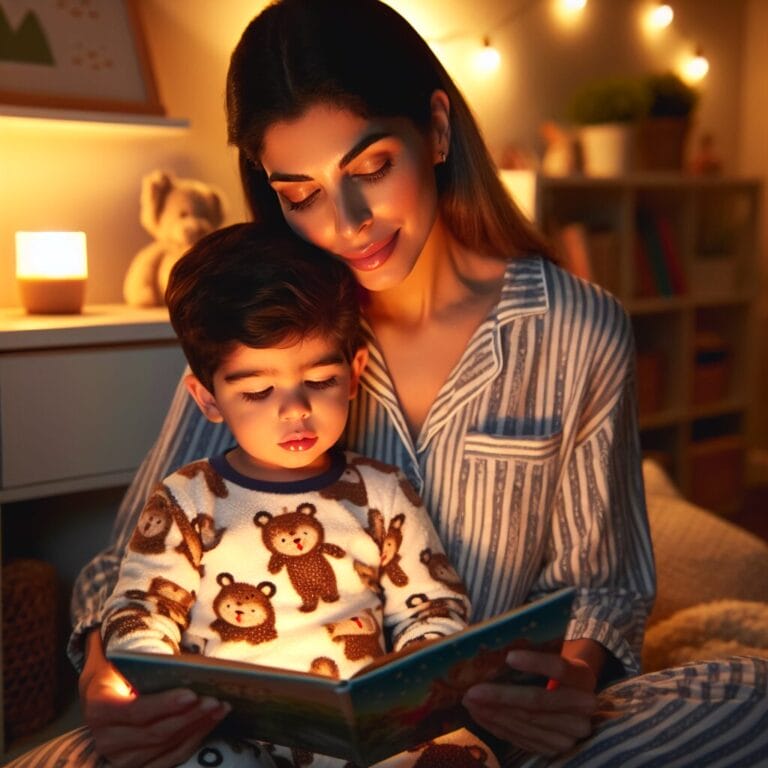
5 Essential Sleep Optimization Tips for Tech-Savvy Toddlers
Table of Contents
- Introduction
- Establish a Consistent Bedtime Routine
- Create a Tech-Free Bedroom Environment
- Encourage Physical Activity During the Day
- Monitor and Limit Content Exposure
- Leverage Sleep-Enhancing Technologies
- Conclusion
- Frequently Asked Questions
Introduction
Let’s unravel the digital cocoon that might be affecting our tech-savvy tots’ nighttime snoozes. In a world where gadgets are as common in little hands as crayons used to be, it’s crucial to ensure these mini tech enthusiasts aren’t losing precious Zzz’s due to their screen time shenanigans. Did you know that pediatric sleep experts are waving red flags about sleep-related lifestyles swinging towards the more ‘plugged-in’ direction? This is because staring at bright screens before bed can trick tiny brains into thinking it’s still daytime, making falling asleep as challenging as convincing them that broccoli tastes like candy!
Now, improving sleep habits goes hand-in-hand with understanding that each night of insufficient sleep can mean grumpier mornings and sluggish days for kiddos. It affects everything from their social development to mental health—think of it like building a house without nails! To keep those little minds and bodies growing strong, we need to foster healthy lifestyle choices early on. And yes, this means taming the tech-beast at bedtime.
Here’s where things get interesting. Sleep hygiene isn’t just about brushing teeth and snuggling under the covers; it includes creating an environment conducive to slumber free from the buzzes and beeps of devices. A calm-down routine brimming with stories (the old-fashioned paper kind) or lullabies can work wonders for sleep onset latency—the fancy term for how long it takes to fall asleep once heads hit pillows.
Moreover, by syncing sleep-wake patterns more closely with natural light cycles rather than screen glows, you’re setting up your toddler for dreamland success. So swap those evening cartoons for some star-gazing or moonlit walks—it’s all about balancing their high-tech daytimes with low-tech bedtimes. Don’t forget, while behavioral therapy sounds suitably grown-up, even simple tweaks such as consistent bedtime routines contribute hugely toward a night filled with sweet dreams over tossing and turning.
Ultimately, adjusting your toddler’s relationship with digital technology isn’t just beneficial—it’s essential for their overall well-being. Let’s instill good ol’ fashioned sleep literacy alongside their ABCs and 123s, ensuring that when heads hit pillows after busy days of learning and exploring, recharge happens efficiently through deep, restorative slumber!
Establish a Consistent Bedtime Routine
Picture this: a pint-sized kiddo, after a busy day filled with learning and plenty of screen time, being gently guided into the land of nod by a bedtime routine that’s as cozy as a warm blanket. Establishing regular before-bed rituals is like setting the stage for Mr. Sandman’s nightly visit – it cues those little brains to downshift from high-speed fun to low-key rest mode. Pediatric sleep experts are all thumbs-up about routines because they help regulate a toddler’s circadian rhythm, making better sleep just another part of daily fun!
Now let’s dive into how you can craft this magical sleep-conducive ritual. Step one: dial down the energy an hour before bed with quieter activities – think building blocks over tablet games or drawing pictures instead of watching TV. Next up, make bath-time part of the wind-down process; bubbles and toys can turn splashing around into relaxation central! Afterward, snuggle up in their favorite PJs for some storytime; while digital books could work, good old paper ones have zero blue light to mess with sleepy signals.
But hey, we’re in the 21st century – digital tech isn’t always the bad guy here! How about using technology smartly? Apps that play soothing nature sounds set the perfect snooze-ambiance without any stimulating visuals. Or consider audiobooks as an alternative to reading; they spin tales that whisk imaginations away without straining those peepers.
As parents navigate these steps, consistency is key – doing things at similar times each night reinforces those zzz-inducing patterns. Plus, it’s important to keep watch on actual shut-eye hours; insufficient sleep can make toddlers more akin to grizzly bears than playful cubs in daytime hours.
Remember – wait no, scratch that (we’re not repeating words here!) – keep in mind that while these rituals might seem like small potatoes against the behemoth of child development milestones ahead, they pave a solid road for both mental growth and social skills sharpening. Sure, adapting screen time habits takes effort when every gadget out there beckons with its shiny lights but balance out those pixels with plenty of pillow time.
So go forth and champion your tot’s nighttime journey! With you as their trusty guide towards improving sleep habits through established routines and smart screen use, you’ll be raising well-rested warriors ready to take on tomorrow’s adventures with gusto!

Create a Tech-Free Bedroom Environment
Did you know that a staggering number of tots are getting less shut-eye than doctors recommend? It turns out those glowing screens can really jumble up little ones’ abilities to drift off into dreamland. Screen exposure before bedtime is like a secret agent, silently working against our kiddos falling and staying asleep. The blue light emitted from these devices messes with their natural sleep-wake patterns, telling their brains it’s time to play, not to lay down for nighttime sleep.
But don’t fret; we’ve got the intel to combat those sneaky sleep snatchers. One super strategy is powering down all gadgets an hour before your tyke tucks in. This “tech curfew” gives their minds a chance to unplug and get ready for some serious snoozing. And guess what? You can turn this gadget-free hour into the best part of the day! How about crafting a pre-bedtime tradition that’s so fun they won’t miss their screens? Think pillow forts, shadow puppets, or a good old tickle fest—laughter is the perfect lullaby!
Now let’s talk bedroom design – turning it into a tech-free oasis can work wonders for your toddler’s sleep health literacy. Keep tablets, TVs, and other digital distractions out of the sleeping zone to make it a calm haven meant just for rest. Picture this: walls adorned with soothing colors, a snuggly bed filled with their favorite stuffed friends (no batteries included), and maybe even some twinkling stars on the ceiling—they’ll be in the Land of Nod before you know it.
Lastly, while screen time isn’t all bad news bears—after all, there are educational apps and shows galore—it’s about creating healthy lifestyle choices that include plenty of restorative slumber. Pediatric sleep experts stress that sufficient sleep duration matters big time for child development; without enough zzz’s, tots can become cranky cookies with plummeting mental development speeds.
So put on your capes, parents—you’re now armed with heroic strategies to improve sleep habits in this high-tech era! From tailored bedtime routines free from digital technology’s buzz to designing serene bedrooms where imagination reigns supreme over pixels—your pint-sized person will be scoring quality slumber in no time!
Encourage Physical Activity During the Day
Ever noticed how a toddler’s batteries seem to recharge at lightning speed? Their boundless energy is astounding, yet harnessing it properly during the day can be the golden ticket to faster falling asleep and sounder nighttime sleep. Let’s plug into some lesser-known power sources that could upgrade those little sleep patterns in a snap!
Physical activity is like natural magic for a tot’s body clock—it gets them sun-drenched and tired out, readying their systems for dreamland. But what kinds of hustle-bustle are best for our tiny humans? Picture this: your bubbly explorer mastering the jungle gym, or perhaps a mini Olympic runner racing through the park—these full-throttle fun sessions not only make them stronger but also nudge that sleep onset latency down when it’s time to hit the sack.
And here’s where balancing act comes into play; mixing screen time with active adventures ensures toddlers don’t become couch-bound drifters in their high-tech worlds. So after they’ve swiped and tapped on educational apps or giggled through cartoon marathons, why not swap screens for sidewalk chalk masterpieces or an impromptu dance party? It’s essential to sprinkle their daily routine with both types of activities—digital exploration followed by energetic exertion—to craft healthy lifestyle choices from the get-go.
As we navigate this teeter-totter of tech and touch grass, consider these rip-roaring activities perfect for pint-sized people:
– Scavenger hunts that turn nature walks into thrilling quests.
– Bubble chasing extravaganzas in the backyard – pop goes the exercise!
– Indoor obstacle courses made from pillows, because who doesn’t love a living room fort?
Pediatric sleep experts give two thumbs up to this dynamic duo approach as it fuels mental development while prepping peepers for closing time. Sleep deprived toddlers are often those missing out on enough romping around during daylight hours. By ensuring they’re sufficiently tuckered out, parents can significantly improve sleep habits, setting up their kiddos for success both at bedtime and beyond.
So let’s give those gadgets a rest before bed and switch gears towards physical feats! By fostering an environment where movement is king during sun-up times, we pave an effortless path toward serene slumbers when stars twinkle high. That’s right – building blocks of social development and mental health one hopscotch jump at a time ensures when night falls over toy-strewn landscapes, dreams aren’t far behind.
Monitor and Limit Content Exposure
Diving into the digital world, toddlers can often encounter a whirlwind of colors, sounds, and stories that captivate their young minds. This stimulation is a double-edged sword—it entertains and educates but can also rev up their mental engines when it’s time to wind down. Pediatric sleep experts are starting to connect the dots between the type of content toddlers consume and their nighttime restlessness. Fast-paced, action-packed shows might leave them wide-eyed when the lights go out, whereas calm, soothing narratives could set them sailing smoothly to dreamland.
To keep their sleep-wake patterns steady as a drumbeat, parents need an arsenal of tools and methods to control screen time effectively. It’s not just about setting limits; it’s about curating content that harmonizes with healthy sleep hygiene. Apps with parental controls can be guardians of bedtime peace, allowing moms and dads to filter out the over-stimulating media as night approaches. And let’s not forget about those handy “do not disturb” settings—digital sentinels ensuring that pings and rings don’t disrupt slumber.
Here are some tips for selecting screen content that nudges those eyelids downward:
– Opt for programs with slower tempos and softer palettes in the evening hours.
– Choose stories rich in calming imagery—think gentle waves or rustling leaves—to prime the mind for relaxation.
– Integrate nature sounds or soft instrumental music as part of the bedtime routine; they’re like an auditory hug that signals it’s time to rest.
Remembering (but not repeating!), insufficient sleep doesn’t just leave toddlers grumpy; it can hinder child development and mental health in significant ways. By introducing quality screen habits alongside established sleep routines, we lay a foundation for lifelong well-being. So let’s guide our little navigators away from treacherous digital tides at bedtime towards shores lined with books, cuddles, and tales that lead straight to zzz’s heaven.
Leverage Sleep-Enhancing Technologies
In the quest to reclaim restful nights for our buzzing, byte-sized youngsters, it’s time we spotlight the unsung heroes in the saga of sleep: tech tools designed with z’s in mind. Imagine a gadget that replaces counting sheep with soft-glowing stars projecting onto the ceiling, or plush toys that double as sound machines whispering lullabies. These innovative sleep aids are not just gimmicks; they’re crafted by pediatric sleep experts who know just how crucial those slumber hours are for child development and mental health.
Tech doesn’t always have to be the villain in our bedtime stories. Used thoughtfully, digital tools can weave tranquility into a toddler’s sleep haven. There’s an array of apps engineered to emit soothing sounds—like rainfall or ocean waves—that can drown out the day’s cacophony, setting the stage for deep nighttime sleep. Even monitors have smartened up, using gentle vibrations to soothe a restless tot back to dreamland without a parent needing to tiptoe in.
But before these electronic allies take their place on your little one’s nightstand, certain safeguards should be in place. It’s essential to keep in mind that introducing any new element into a tot’s bedtime routine requires a careful balancing act. Here’s what you need to consider:
– Always prioritize devices that are free from disruptive lights and stimulating interactions.
– Ensure volume settings are at a level conducive for sleep—not too loud to startle, but audible enough to comfort.
– Choose gadgets that automatically power down after easing your youngster into slumber land.
Let us not forget that while these technologies serve as aides-de-camp in improving sleep habits, they do not replace the warmth of human touch or the comforting cadence of a whispered bedtime story. In this high-tech age where screen time is often demonized for its impact on healthy lifestyle choices, it’s refreshing to see positive use cases emerge—turning digital technology into an ally rather than an adversary when it comes to enriching toddlers’ sleep hygiene and bolstering their overall well-being.
| Type of Technology | Description | Sleep Expert Involvement | Intended Effect | Safeguards to Consider |
|---|---|---|---|---|
| Star Projectors | Devices that project calming star patterns onto the ceiling. | Crafted by pediatric sleep experts. | Replace counting sheep, aid in relaxation. | No disruptive lights; auto power-down feature. |
| Sound Machine Plush Toys | Plush toys with built-in sound machines that play lullabies. | Designed with child development in mind. | Provide auditory comfort for sleep. | Volume at sleep-conducive levels. |
| Sleep Apps | Apps that emit soothing sounds like rainfall or ocean waves. | Engineered to promote tranquil sleep environments. | Drown out daytime noise, set stage for deep sleep. | Free from disruptive interactions; appropriate volume settings. |
| Smart Monitors | Devices that use vibrations to soothe a restless child. | Incorporate smart, soothing techniques. | Comfort without parental presence. | Non-intrusive, auto power-down after child falls asleep. |
| Note: While these technologies are helpful, they do not replace human interaction or the comfort of bedtime stories. | ||||
Conclusion
In the lively households where toddlers navigate both playgrounds and touchscreens, the quest for quality slumber becomes a pivotal part of daily life. Here’s a wake-up call: clear connections have been established between daytime giggles and nighttime wiggles, emphasizing that laughter and play are not just joys but necessities in paving the way to restful sleep. As parents orchestrate their little one’s journey from sunup adventures to bedtime tranquility, they hold the keys to unlocking patterns that promote healthy growth and vibrant minds.
It’s about crafting a sanctuary where dreams can flourish, undisturbed by the pings and dings of digital intrusions. Bridging the gap between screen time savviness and serene sleep involves infusing each day with activities that stretch those tiny muscles—like pirate treasure hunts or fairy garden creations—that naturally segue into peaceful slumbers without battles over bedtime. Encourage imaginative play that doesn’t just sparkle during daylight but also sprinkles stardust on their sleepytime transitions.
Parents are the conductors of this symphony, harmonizing tech rhythms with life’s natural beats. In fostering environments where iPads dim as twilight whispers its arrival, children learn to associate certain cues—a soft blanket, a bedtime tale—with falling asleep effortlessly. And let’s cast a spotlight on silent guardians like sleep-friendly nightlights or white noise machines that provide comfort without chaos; they’re understudies supporting parental presence even when offstage.
By integrating these threads—physical activity stitching together with digital downtime into a cozy quilt of routine—the narrative weaves itself: Tech-savvy tots don’t just close their eyes; they embark on nightly voyages through dreamscapes crafted by loving hands guiding them away from blue-light oceans towards lullaby shores. Mental health blooms as these sleep habits root themselves deep within childhood’s tapestry, safeguarding against sleep problems and setting sail toward tomorrow’s sunshine-filled escapades.
So let us remember (without being repetitive), whether it’s through story arcs shared under starlit ceilings or treks through living room jungles before dusk falls, our role in shaping toddlers’ worlds is profound. Beyond screens lies an expanse where imagination plays hero and sleep is its superpower, ensuring every “goodnight” is also a “sleep tight,” wrapped up in dreams only a well-rested child can weave.




